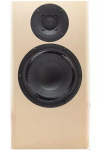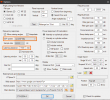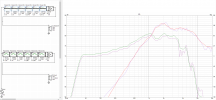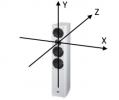Sorry folks for the late post, had a lot going on and my computer is a piece of.... uhm problems.
As mentioned in other posts,
@Rick Sykora had to replace the Directiva r1 woofer that Amir measured with the NFS due to a defect.
Due to the fact that the new woofer deviates significantly in frequency response, the design of a passive crossover becomes a bit tricky.
In the following I describe step by step my procedure (it is probably "description overkill", because you could describe the whole thing in one sentence).
So everyone can also use his own on-axis measurements from the SeasDXT tweeter and Purifi woofer in the speaker cabinet.
1.
Here are the on-axis frequency responses measured by Rick. The Seas tweeter (the same driver that was measured with the NFS) and the "new" Purifi woofer measured individually in the speaker cabinet.
Both measurements were taken with the microphone position unchanged, at the height of the tweeter, @1.5m distance -
@Rick Sykora correct me if I am wrong, the correct value is important.
So, the tweeter axis serves us as a reference axis (this was determined by the team, since most users use it as a guide when setting up the speakers)

Down to about 200-300Hz you can see Rick's gated in-room measurement of the "new" woofer, below that the NFS measurement of the "old" woofer has been used (to get a complete frequency response down to 20Hz).
2.
Now we overlay Rick's measurements with the old on-axis NFS measurements from SeasDXT (red) and the old Purifi woofer (green).

Ideally, the measurements of the tweeter (which was identical in Rick's and the NFS measurement) should be more or less congruent, after a sound pressure level equalization.
The deviations in the comparison of the tweeter measurements should for the most part (besides things like temperature, microphone alignment,...) be due to measurement errors and measurement tolerances of the measurement systems used.
What is clearly noticeable, however, are the considerable deviations when comparing the woofer measurements. Roughly 1dB difference in sound pressure level and in the frequency range 1-4kHz a completely different frequency response.
We have already speculated a lot about the possible reasons. To keep the possible sources of error as small as possible, it should be ensured that the Purifi driver has identical orientation (orientation of the surround bulges) as in the original Directiva r1 Amir measured - I think
@Rick Sykora has paid attention to this.
 3.
3.
In the next step I used PEQ in VCAD to adjust the frequency responses so that they coincide (for the woofer I lowered the level by 1dB).
For the drivers, I set a smoothing of 1/6oct in VCAD to make it easier to create a match.

Now only the 1dB correction for the woofer has to be undone:
 4.
4.
Now the settings in VCAD should be checked in any case.
Since Rick performed his measurements at a distance of 1.5m (with tweeter axis fixed mic), the corresponding value should also be set under "
Listening distance".
This optimizes the speaker for a listening distance of 1.5m, but the phase error around the crossover frequency (2.3 - 2.5 kHz) is less than 10° at 3m listening distance - so it doesn't matter much.
(when using your own measurements, check this setting first)
For the PEQ I selected the setting "miniDSP96" under "
DSP system". The selection was rather random, but to prevent the frequency responses from changing, you should set the same selection.

Since the tweeter has not changed, the NFS measurements should actually be okay, so I have commented out the adjustments for the SeasDXT (but everyone can handle that as they like).

So this is our VCAD project adapted to the new woofer with the NFS measurements for Directive r1.
You can find this as an attachment "corrected_NFS_0".
There you can now build your passive crossover normally.
As an example I took the crossover of Tim - see attachment "corrected_NFS_XO-Tim1".

And always keep in mind that the drivers you use will also have other deviations, so it makes sense to make your own measurements to check for an optimal result after building the crossover. If the deviations are too severe, you can adjust the crossover accordingly.
Will get back to you later with some details.











